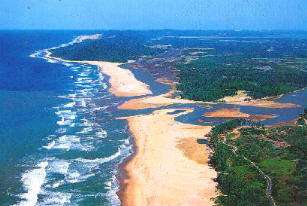Marine reptile
Marine reptiles are reptiles which have become secondarily adapted for an aquatic or semiaquatic life in a marine environment.

• Saltwater crocodile (top left)
• Sea turtle (top right)
• Marine iguana (bottom left)
• Sea snake (bottom right)
The earliest marine reptiles arose in the Permian period during the Paleozoic era. During the Mesozoic era, many groups of reptiles became adapted to life in the seas, including such familiar clades as the ichthyosaurs, plesiosaurs (these two orders were once thought united in the group "Enaliosauria",[1] a classification now cladistically obsolete), mosasaurs, nothosaurs, placodonts, sea turtles, thalattosaurs and thalattosuchians. After the mass extinction at the end of the Cretaceous period, marine reptiles were less numerous, but there was still a high variety of species in the early Cenozoic, such as "true" sea turtles, bothremydids,[2] palaeophiid snakes, a few choristoderes such as Simoedosaurus and dyrosaurid crocodylomorphs. Various types of marine gavialid crocodilians remained widespread as recently as the Late Miocene.[3]
Currently, of the approximately 12,000 extant reptile species and subspecies, only about 100 are classed as marine reptiles: extant marine reptiles include marine iguanas, sea snakes, sea turtles and saltwater crocodiles.[4]
Some marine reptiles, such as ichthyosaurs, plesiosaurs, metriorhynchid thalattosuchians, and mosasaurs became so well adapted to a marine lifestyle that they were incapable of venturing onto land and gave birth in the water. Others, such as sea turtles and saltwater crocodiles, return to shore to lay their eggs. Some marine reptiles also occasionally rest and bask on land.
Extant (living) varieties
- Sea turtles: there are seven extant species of sea turtles, which live mostly along the tropical and subtropical coastlines, though some do migrate long distances and have been known to travel as far north as Scandinavia. Sea turtles are largely solitary animals, though some do form large, though often loosely connected groups during nesting season. Although only seven turtle species are truly marine, many more dwell in brackish waters.[4][5]
- Sea snakes: the most abundant of the marine reptiles, there are over 60 different species of sea snakes. They inhabit the tropical and subtropical waters of the Indian and Pacific oceans, though very limited reports of sightings suggest they may be extending into the Atlantic Ocean. Sea snakes are venomous and their bites have been known to be fatal, though generally they only bite when provoked and often inject only a very small, non-fatal quantity of venom. Sea snakes are distinguished from terrestrial snakes by a vertically flattened tail.[4][6]
- Marine iguana: marine iguanas live only on the Galápagos Islands and are not fully adapted to marine life. Although they feed exclusively on marine plants and spend a good deal of their time in the water, they do nest on land and need to bask in the sun to reach their ideal body temperature; they are thus also subject to terrestrial predators.[4][7]
- Saltwater and American crocodiles: none of the extant species of crocodiles is truly marine; however, the saltwater crocodile (Crocodylus porosus) does display adaptations to saltwater inhabitation and dwells in the brackish waters of Southeast Asia and Australia. Saltwater crocodiles dispose of excess salt in their bodies through specialized salt glands. These are the largest species of crocodile, also making them the largest reptiles. They can grow up to six meters in length.[4][8] American crocodiles (Crocodylus acutus) similarly prefer brackish over freshwater habitats.[9]
Adaptation to the marine environment
Conservation
Most species of marine reptiles are considered endangered to some degree. All but one species of sea turtles are endangered due to destruction of nesting habitats on coastal lands, exploitation, and marine fishing;[5] many species of sea snakes are threatened or endangered due to commercial exploitation (sale of skins) and pollution especially in Asia; marine iguanas are threatened due to their very limited habitation range.[4] Saltwater crocodiles are at low risk for extinction.[8]
References
- Williston SW (1914) Water Reptiles of the Past and Present University of Chicago Press (reprint 2002). ISBN 1-4021-4677-9
- Anny Rafaela de Araújo Carvalho; Aline Marcele Ghilardi; Alcina Magnólia Franca Barreto (2016). "A new side-neck turtle (Pelomedusoides: Bothremydidae) from the Early Paleocene (Danian) Maria Farinha Formation, Paraíba Basin, Brazil". Zootaxa 4126 (4): 491–513. doi:10.11646/zootaxa.4126.4.3.
- Langston, W. and Gasparini, Z. (1997). Crocodilians, Gryposuchus, and the South American gavials. In: Kay, R. F., Madden, R. H., Cifelli, R. L. and Flynn, J. J., eds., Vertebrate Paleontology in the Neotropics: The Miocene fauna of La Venta, Colombia. Washington, D.C. Smithsonian Institution Press, pp. 113-154.
- Rasmussen, Arne Redsted; Murphy, John C.; Ompi, Medy; Gibbons, J. Whitfield; Uetz, Peter (2011-11-08). "Marine Reptiles". PLoS ONE. 6 (11): e27373. doi:10.1371/journal.pone.0027373. PMC 3210815. PMID 22087300.
- Zug, George R. "Sea Turtle". Encyclopædia Britannica Online. Retrieved December 8, 2015.
- "Sea Snake". Encyclopædia Britannica Online. Retrieved December 8, 2015.
- "Marine Iguanas". National Geographic. Retrieved December 8, 2015.
- "Saltwater crocodile". National Geographic. Retrieved December 8, 2015.
- Ellis, T. M. (1981). "Tolerance of Sea Water by the American Crocodile, Crocodylus acutus". Journal of Herpetology. 15 (2): 187. doi:10.2307/1563379. JSTOR 563379 1 563379.

